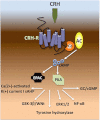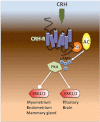Insights into mechanisms of corticotropin-releasing hormone receptor signal transduction
- PMID: 21883143
- PMCID: PMC3415640
- DOI: 10.1111/j.1476-5381.2011.01631.x
Insights into mechanisms of corticotropin-releasing hormone receptor signal transduction
Abstract
During evolution, mammals have developed remarkably similar molecular mechanisms to respond to external challenges and maintain survival. Critical regulators of these mechanisms are the family of 'stress'-peptides that consists of the corticotropin-releasing hormone (CRH) and urocortins (Ucns). These neuropeptides 'fine-tune' integration of an intricate series of physiological responses involving the autonomic, endocrine, immune, cardiovascular and reproductive systems, which induce a spectrum of behavioural and homeostatic changes. CRH and Ucns exert their actions by activating two types of CRH receptors (CRH-R), CRH-R1 and CRH-R2, which belong to the class-B1 family of GPCRs. The CRH-Rs exhibit signalling promiscuity facilitated by their ability to couple to multiple G-proteins and regulate diverse intracellular networks that involve intracellular effectors such as cAMP and an array of PKs in an agonist and tissue-specific manner, a property that allows them to exert unique roles in the integration of homeostatic mechanisms. We only now begin to unravel the plethora of CRH-R biological actions and the transcriptional and post-translational mechanisms such as alternative mRNA splicing or phosphorylation-mediated desensitization developed to tightly control CRH-Rs biological activity and regulate their physiological actions. This review summarizes the current understanding of CRH-R signalling complexity and regulatory mechanisms that underpin cellular responses to CRH and Ucns.
© 2011 The Author. British Journal of Pharmacology © 2011 The British Pharmacological Society.
Figures






References
-
- Aggelidou E, Hillhouse EW, Grammatopoulos DK. Up-regulation of nitric oxide synthase and modulation of the guanylate cyclase activity by corticotropin-releasing hormone but not urocortin II or urocortin III in cultured human pregnant myometrial cells. Proc Natl Acad Sci USA. 2002;99:3300–3305. - PMC - PubMed
-
- Assil IQ, Qi LJ, Arai M, Shomali M, Abou-Samra AB. Juxtamembrane region of the amino terminus of the corticotropin releasing factor receptor type 1 is important for ligand interaction. Biochemistry. 2001;40:1187–1195. - PubMed
-
- Audsley N, Kay I, Hayes TK, Coast GM. Cross reactivity studies of CRF-related peptides on insect Malpighian tubules. Comp Biochem Physiol A Physiol. 1995;110:87–93. - PubMed
-
- Bale TL, Vale WW. CRF and CRF receptors: role in stress responsivity and other behaviors. Annu Rev Pharmacol Toxicol. 2004;44:525–557. - PubMed
Publication types
MeSH terms
Substances
Grants and funding
LinkOut - more resources
Full Text Sources
Other Literature Sources
Molecular Biology Databases
Miscellaneous

